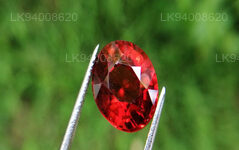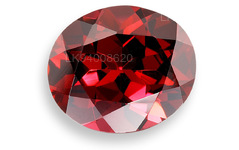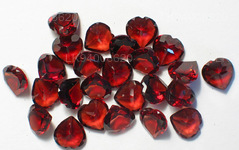
Gems
Sri Lanka’s gem industry has a very long and colorful history. Sri Lanka was affectionately known as Ratna-Dweepa which means Gem Island. The name is a reflection of its natural wealth. Marco Polo wrote that the island had the best sapphires, topazes, amethysts, and other gems in the world.
Garnet
-
Species:
Rhodolite- violet to purplish-red;
Almandite – red, brownish-red, violetish-red or purple;Pyrope red;
Grossularite – green, yellow, brown, white, colourless, light violet, red, orangey-red; Varieties: hessonite (orange to brown), transparent, green, grossularite (tsavorite);Some show a colour change from a mauve-brown to orange-red.
Andradite – green, yellow, black. Green called demantoid (high lustre and dispersion);
Spessartite – yellow to yellow-brown, dark orangey-brown, reddish-orange, orange;
Uvarovite – emerald green, found only in tiny sizes, usually opaque. -
Sources:
Rhodolite – Sri Lanka, North Carolina, Tanzania, Kenya, South Africa, Brazil.
Almandite – Sri Lanka, India, Brazil, star from Idaho – USA.
Pyrope – Czechoslovakia, South Africa, Zimbabwe – Rhodesia, Brazil, Arizona.
Grossularite – Sri Lanka, Brazil, Tanzania, Kenya, South Africa, Canada.
Andradite – demantoid: Russia, Italy; translucent yellowish or greenish-brown, Arizona.
Spessartite – Sri Lanka, Burma, Brazil, Madagascar, Tanzania, Kenya.
Uvarovite – Russia, Finland (hardly mined at all). - Toughness: Fair to good
- Treatments: Almost all aquamarine is heat-treated to enhance its blue colour. Irradiation with neutron, gamma rays or with x-rays. Colour change is permanent and is an accepted practice. A morganite (pink beryl) turns deep purple blue (Maxixe type) upon ultraviolet irradiation, though the colour is not stable.
- History: Since earliest times garnets have been carried as amulets against accidents in travel. Asiatic peoples and even our Southwest Indians used them as bullets, believing that their rich, glowing colour might cause more deadly wounds. The Persians have given the garnet a favoured place as a royal stone, allowing it to bear their sovereign’s image. Red garnet was once used to relieve fever, yellow garnet to cure jaundice. If the powder failed, the apothecary was accused of using a substitute.
- Cuts & Uses: Usually faceted. Sometimes carved into intaglios.
Explore Gem Mines
-
Explore Gem Mines in Ratnapura from Negombo
Regular price From $88.00 USDRegular priceUnit price / per -
Explore Gem Mines in Ratnapura from Colombo
Regular price From $123.13 USDRegular priceUnit price / per$132.60 USDSale price From $123.13 USDSale -
Explore Gem Mines in Rathnapura from Kalutara
Regular price From $152.92 USDRegular priceUnit price / per$191.15 USDSale price From $152.92 USDSale -
Explore Gem Mines in Ratnapura from Mount Lavinia
Regular price From $178.20 USDRegular priceUnit price / per$222.75 USDSale price From $178.20 USDSale






























